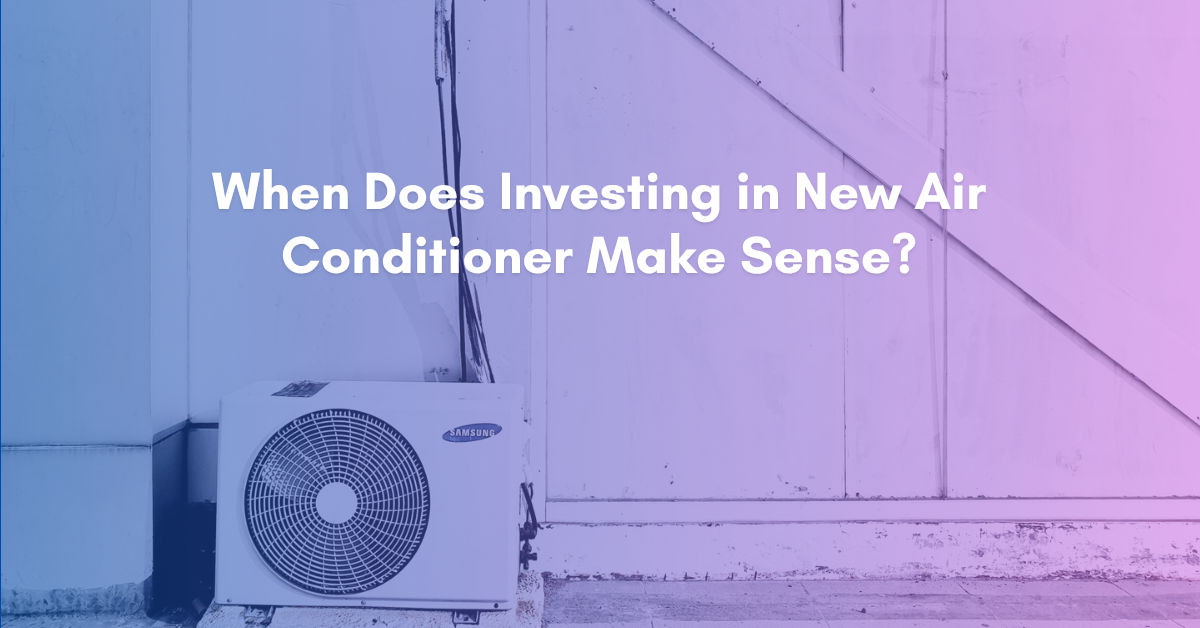Table of Contents
Introduction: Record High on Electrical Bill
It’s getting hotter and hotter in Malaysia, the hot weather and humidity make us use air conditioner way more often, and as the consequence, our electricity bill has sky rocketed, and in last month our monthly electrical bill just hit a record high.

Keep in mind our house also has solar system installed, the same month our solar system generated 864kWh and sold back 376kWh to TNB under NEM scheme, it still proven it self to be a great investment with ~RM572.8 saved (included all kind of taxes.)
With our 60 months installment plan, the recurring payment is RM567, so we are not even forking out more from what we have to pay anyway, in 3 more years once the installment is fully paid we still have 5 year of NEM contract and from there it will be pure savings.
Anyway let’s get back to our main topic, so the record high bill is still concerning and I need to figure out what is the main cause and see if there is anyway to reduce the bill.
What I Cannot Control: ICPT & Taxes
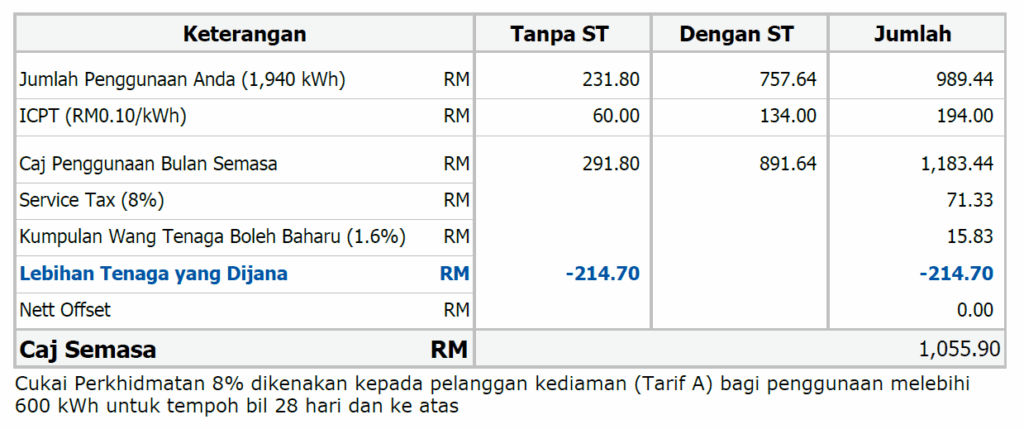
If you notice there is a bunch of “tax the rich (middle class)” bullshit in this bill, if electricity bill is fairer and doesn’t penalize middle income or family with more members living together (maybe because it’s too expensive to buy a new house in the first place?), then the actual bill should be just RM774.74
In other words the effective taxes rate are 36.29% and we are paying on average RM0.675 per kWh, well it’s not the highest in the world, but definitely not the cheapest, in fact it’s probably in the higher rank compare to other developing nations.
Alright enough with the ranting, I can’t control these, so let’s just focus on what I can actually control, finding out the main electricity drainer at my house.
Large Electrical Appliance in My House
There are 10 unit of air conditioner in my house, 2 unit of refrigerator, a few desktop computer, and other stuff like water heater, TVs, etc.
The computer are easy measure, for my server I have UPS which report the average load, for other computer I just use smart socket like Tapo P110 from TP-Link to measure, but on average all of computer at my home uses around 230kWh per month, which explained for only 10% of the bill.
However, I believe the majority of the usage still come from the air conditioner, we have 5 unit which will be use for 10 hours a day, then the rest are momentarily used, but most of the unit are nearly a decade old and they are non inverter unit.
So I decided to figure out if it’s worth changing all the frequently use air conditioner to newer inverter unit, but first we have to learn how to estimate the cost of air conditioner, and there are a few ways:
- Install CT clamp at the switch box with monitoring device (eg: Shelly Pro 3EM), which give the most accurate data over longer period of tracking.
- Use a digital clamp meter directly on the switched live wire at the wall switch, but it only give me snapshot reading, hardly accurate due to non inverter air conditioner power cycling.
- Use rough estimation based on the product specifications

These however are expensive for the one off purpose, requiring hire professional electrician and are too troublesome for me, so I decided to start simple, using rough estimation based on the product specifications, because I can still apply margin of error and if they still show a huge saving potential then that will be enough for making decision.
Finding The Cost of Running Air Conditioner
Let’s start with the old air conditioner I use in my home office, it is CS-PC9MKH from Panasonic and compare it with the Daikin inverter AC (FTKP28AV1MF) in my bedroom, and here is the specifications
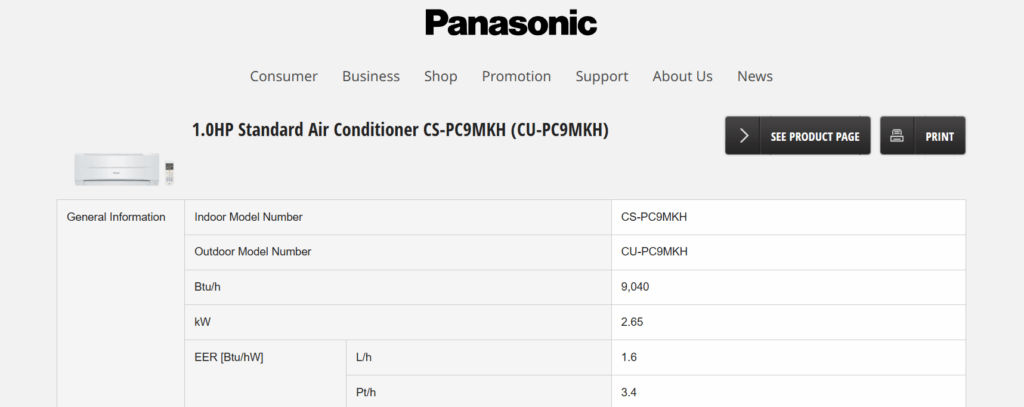

Non inverter air conditioner are simple to calculate, the way they work is there is a built in thermostat which will tell the compressor to work to bring the temperature to the unit you set, now unlike inverter AC, the compressor will only run in 100% or 0%, meaning ether on or off, drawing nearly all the 865W.
(For rough calculation we will ignore the electrical usage from the indoor unit’s fan.)
Now we will need to make an assumption here, which is the average duty cycle per hour, what it means is how often does the thermostat find the room temperature is above your desired temperature and keep the compressor working, now this is highly varied depends on the weather, the time you use air conditioner (night/noon), and the temperature you use, for this air conditioner I use in my office during day time I will use 60%.
And if I use this air conditioner for 12 hours a day, this give us an estimation usage of:
865W * 0.6 * 12 * 30 = 186.84kWh (≈ RM 126)To make it comparable with the inverter AC in my room, which the compressor work at varying level, the best way is to find out the total cooling it delivered (that 2.65kW in the spec sheet)
2.65kW * 0.6 * 12 * 30 = 572.4kW of cooling capacityDon’t be confuse by the same measurement unit kW, kW is a unit of power, in this case is thermal power, not electrical power, think of the 572.4kW as the “total heat removed” and the 186.84kW as the “cost”.
Comparing with Inverter AC
The inverter AC I use in my bedroom is Daikin FTKP-A and here is the specifications
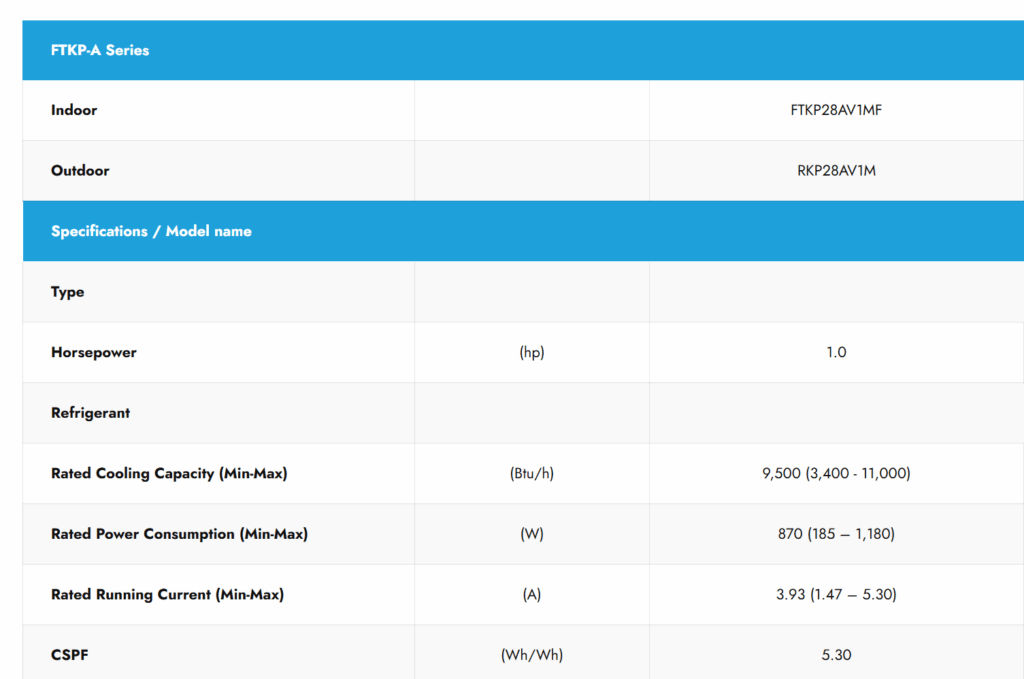
This is the easier part most newer air conditioner spec sheet will provide CSPF, which is a more modern metric and direct measurement on how much heat remove per watt, so what we need is just to find out how much it will cost the inverter AC to remove the same amount of heat:
572.4kW / 5.3 = 108kWh (≈ RM 73)The difference of RM53 is the potential saving per month if I use the inverter AC in my home office room, now it’s time to look from it on economic lens, after all economics is just applied science to help us decide the better choices in our life, so it become natural for me to compare cost and return of everything.
Are Inverter AC Worth Investing?
The cost of my inverter AC and the installation is RM2200 back in March 2025 when I replace my broken unit in my bedroom.
With RM53 saving per month that translate to RM636 saving per year, that is 28% of the cost of RM2200 and it’s easily tell us this is an incredible return on investment, and it’s basically a risk-free investment.
And don’t forget at that rate of return it gives us a lot of margin for error on my already conservative calculation (decade old unit tend to use more cost to deliver the same cooling capacity), even if I lower my duty cycle estimation from 60% to just 40% it will still give me 19.3% rate of return.
In conclusion it is definitely worth to replace the non inverter air conditioner in my home office to an inverter AC.
Another Example of 2HP Non Inverter AC
Next I’ll just need to repeat the same estimation for other units with their estimated usage, I’ll do one more example, the 2HP non inverter AC in my living room.


We don’t use this air conditioner as much as the one in bedroom or home office, while I did not track specifically how much we use this AC, but let’s just assume we use it for 6 hours for around 20 days with 60% duty cycle, here is the cost and cooling capacity:
1.95kWh * 0.6 * 6 * 20 = 140.4kWh (≈ RM 94.77)
5.28kW * 0.6 * 6 * 20 = 380.16kW of cooling capacityThis time we will look at a different brand, we will use back Panasonic brand because it still one of the more reputable brand, in the same league as Daikin, for this we look at the 2HP model CS-CU-KU18AKH-1
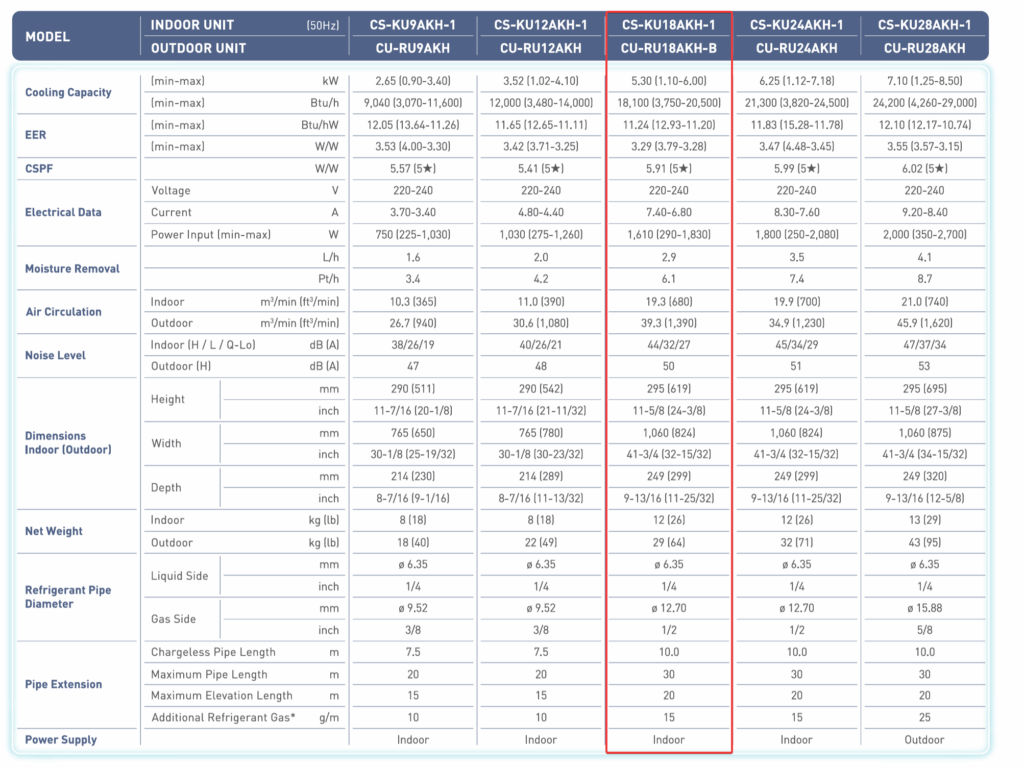
And calculate how much electricity it will cost to remove the same amount of heat:
380.16kW / 5.91 = 64.32kWh (≈ RM 43.42)Which give us a savings of RM51.35 per month or RM616 per year, it saved similar amount but with the higher price in 2HP air conditioner, for this unit include installation is around RM3800 it only give us a rate of return of 16%, not too shabby but not as huge as the previous one.
What Brand To Choose?
Now this is not a product review blog but here are some models I personally comparing between some of the popular brands and their top models by CSPF in Malaysia, most importantly I only included models that I can find where to buy and price with installation.

From my comparison the model with higher CSPF and higher monthly saving are almost always better investment in the long run, for example the Panasonic CS-PU9AKH-1 has 40% rate of return in first year, but because of the smaller saving in just 5 years it will end up costing the same as the CS-XU10ZKH, and in 10 years it will be worse than it.
Thus it make more sense to go with the latest flagship model from Panasonic than their older lower tier model. Similar case for Daikin too, I will certainly go with their FTKM25 flagship model rather than the older model.
The other brand is not really within my consideration because in my opinion they have far lesser reliability and years in market to prove themself yet, plus other than the Midea MSAI-10, both the Haier and Acson will end up as worse investment from year 5~6, that is if they can even last for that long.
(Excluding Samsung too because my previous Samsung flagship AC broken in less than 2 years.)
By the way the 10 year table are simply my way of measuring the net financial position, it’s simply assume I have RM10k, and bought the AC, pay for the monthly cost, while letting the rest of the balance invested in market with 10% annual compounding.
(I know for some people this is “over calculation for couple hundreds difference in 10 years period” but finding the true cost is a fun exercise for me, and it certainly help me to stay sharper when managing my investment when I employ the mentality of every 0.01% matters.)
How Much Did I Saved?
I have placed order to replace 3 frequently used air conditioner in my house to the Panasonic XU series model, my expectation are not only they will use less electrical usage than my previous unit from 712kWh to ~300kWh, the difference will also make it just enough to trim my monthly usage to under 1500kWh which effectively avoided ICPT and yielded the best return.
I will post an update to this post in coming few months once I have some real data to show.
Closing Thoughts
As we can see the rate of return are mostly influence by the usage, it will only make sense when the AC are frequently used, so needless to say the other unit in my house that only use once in a while are probably not going to be worth to upgrade at this moment.
Another way we can increase the rate of return which is to choose a cheaper brand or series, with less features but ultimately make sure to compare the CSPF, a cheaper product with much lower CSPF may end up saving less per ringgit spent. (Plus we still want something reliable and safe)
On top of that to make the investment even better we can look for ways to put our purchase on installment plan with low or zero interest, for example with our Alliance Bank virtual card, or just find shop that provide installment plan but have the same price.
I hope this thought process will help you to decide whether you should invest in a new air conditioner to reduce your electricity bill, the same logic should applies on everything else, for example refrigerator.

